#winged sumac
Explore tagged Tumblr posts
Text
Winter Solstice is a Beautiful Time in Florida
Solstice Sumac Many people consider the period around the winter solstice to be a beautiful time of the year. They have fresh snow (or the hope of fresh snow) on the ground and covering the trees and shrubs. But down in central Florida, we don’t get snow but it is cool enough to keep our colorful wildflowers from growing and our grasses and tree leaves from being green. It tends to be a rather…
#beautiful berries#berries#berry photographs#berry photography#brown berries#Florida native plants#native plants in winter#plant photographs#plant photography#plants#plants in winter#sumac#sumac berries#sumac photographs#sumac photography#Winged sumac#winged sumac berries#winter berries#winter in Florida#winter in Florida nature#winter solstice
0 notes
Text
saddest thing ever.
Someone had what was clearly a giant, fruiting winged sumac growing and chopped it down :(


[ID: Two photos of a white hand holding a compound leaf from a winged sumac plant. The leaf is very long, with long, skinny leaflets with smooth edges. The tops of the leaves are dark green, and paler green on the bottom with some fuzziness on the stem. Along the top side of the stem are thinner leaf-like surfaces where it gets the name "Winged" sumac from. End Id.]
I got a big section of stem, so maybe I'll be able to clone it?
Also got some dried clusters of berries so might actually get to save seeds.
The berries of this species are used to make a drink by steeping the berries in water to make a fruity "sumac-aid" (a pun on lemonaid).
Haven't tried it yet because for some reason last year I had identified this one correctly somehow thought this one was poisonous...but no that's a completely different one that looks completely different. I've got not clue how I managed that.
Maybe I was mixed up because the ones in PA weren't edible...
also dyslexia strikes again. This is Rhus copallinum. I was saying copanellium.
Also called shining sumac. But winged sumac is more descriptive.
1 note
·
View note
Text

My oc Sumac. She is my baby and I love her forever. She is based of my favorite shrub ever Staghorn Sumac. Sumac is really cool cuz you can make a lemonade out of its fruit and it is very tasty. While Staghorn Sumac is not poisonous there are many poisonous variations so please be careful around them. That is why I am unsure if I should make her a Sapwing or a Poisonwing. The only likes gardening and hates any other creatures
Additional photo:

#wof#wings of fire#wof art#leafwing#I wanted to talk more about her backstory but I just ended up talking about one of my favorite plant species#sumac is just one of my favorites tho#I really like the American sycamore#or the weeping Norway spruce#if you couldn’t tell already plants are my special interest#i really like them#I think there neat#my art
35 notes
·
View notes
Text


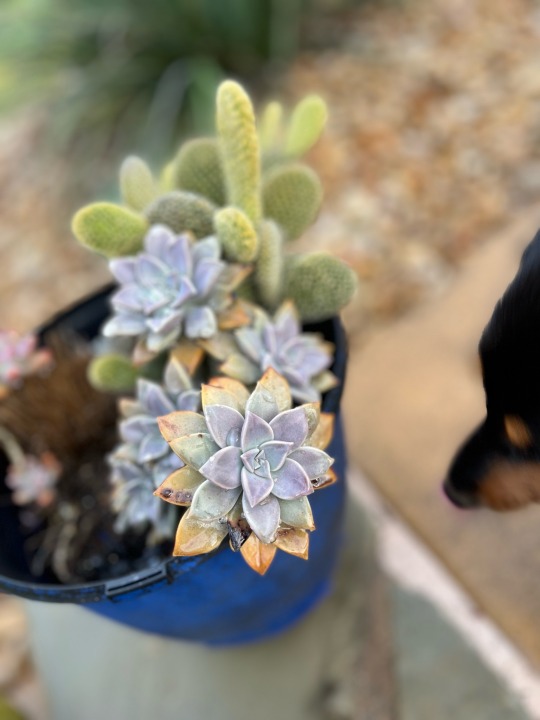

Texas Winter 2023 🌧️
The Common Clover, Smooth Sumac, and various succulents and cacti my dogs photobombed.
The Smooth Sumac is one one of the most vibrant, fall colored shrubs I have ever seen. In a sea of brown and green it is a mini sunset bursting to life.
#get blasted with plants and shrubs idiot/ jkjk#bread#flowers#shrubs#cottegecore#my photos#photos#succulents#clovers#plants#photography#art#my art#Where I live we don't often get snow. Usually just ice and rain. But with global warming ice is less frequent in early Winter.#surprisingly there are more than a few plants and flowers that thrive in Texas Winters. Rainfall is plentiful.#smooth sumac#sumac#its either the smooth sumac or winged sumac but its so young im not sure if I can tell yet
71 notes
·
View notes
Text
Magical Oil Recipes - Glamour Edition

For anyone looking to brew up some magic related to glamours, confidence, physical appearance, or eloquence, here are some recipes I’ve created that you might find useful.
To prepare them, blend the ingredients in such proportions as feels correct for your purposes (or as supplies allow). Use dried material except where indicated. Place a few spoonfuls in a mason jar with a screwtop lid and fill the jar with a bland oil of your choice. (Vegetable oil of the sort you would buy for cooking works fine.) Screw the lid on tightly and shake well to combine, then leave the jar in a dark dry place for 2-4 weeks to steep.
Once steeped, prepare a clean storage bottle (also with a secure lid) and label with the type of oil and the bottling date. Strain the oil through paper towels or cheesecloth to remove the plant material, then bottle immediately. Store away from sunlight and heat for up to one year. Use for spellwork as you see fit.
(Please note that NONE of these potions are meant to be taken internally by any means. Observe all proper safety measures related to glass, fire, and potentially harmful plants as necessary during preparation.)
*- Ingredient is potentially harmful if inhaled or ingested. **- Ingredient should not be used or handled if you are pregnant or nursing.
Belle of the Ball Beauty Oil For beauty glamours.
Orange Peel
Magnolia Petal
Maidenhair Fern
Primrose Blossoms**
Brand New Me Transformation Oil For self-improvement, physical changes, or personal growth.
Fennel
Lady's Mantle**
Pine Needles
Geranium Essential Oil Note: If your personal journey includes adjusting to a change in gender or sexuality, add a few Persimmon seeds to the mix.
Honeytongue Eloquence Oil For verbal persuasion and effective speech.
Honeysuckle
Orris Root
Licorice Root
Marshmallow Root** Note: Do not consume.
Increase the Thing Empowerment Oil For self-empowerment and glamours pertaining thereto.
Petunia Petals
Bergamot
Lemon Verbena
Sunflower Petals
It Wasn't Me Diversion Oil For diverting suspicion from yourself or your actions.
Dogbane (Black Hemp)
Cherry Bark
Blueberry Leaves
Marshmallow Root**
Lionheart Courage Oil For bravery and confidence spells.
Black Tea Leaves
Bay Leaf
Cedar Tips
Thyme Sprigs
Own the Runway Confidence Oil For supreme confidence.
Yarrow**
Sumac Berries
Ginger Root, Fresh
Pass Unseen Stealth Oil For perceived invisibility glamours.
Cherry Bark or Blossoms
Poppy Seeds**
Devil's Shoestring**
Dogwood Blossoms (if available)
Tearoom Forbearance Oil For when you need to keep your temper…no matter what.
Tea Leaves
Meadowsweet**
Echinacea**
Fir Balsam Essential Oil
Should the reader require supplies, I recommend the following:
Penn Herb Company
Starwest Botanicals
Bulk Apothecary
Mountain Rose Herbs
Specialty Bottle
Photo Credit - VeraPetruk
All recipes are © 2017 Bree NicGarran, published in Pestlework: A Book of Magical Powders & Oils. Please check out the book if you would like more recipes.
If you’re enjoying my content, please feel free to drop a little something in the tip jar, tune in to my podcast Hex Positive, or check out my published works on Amazon or in the Willow Wings Witch Shop.
413 notes
·
View notes
Text
common toxic plants
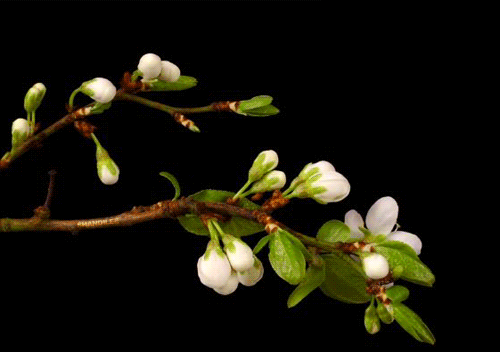
this is not a complete list by any means, but these commonly noted plants, herbs, and flowers should be handled with care or avoided altogether.
aconite (wolfsbane, monkshood) - all parts: dermatoxic, hepatotoxic, and neurotoxic
adam and eve (jack-in-the-pulpit, wild arum) - root: dermatoxic and gastrotoxic if ingested
african sumac - leaves: dermatoxic; possibly fatal
agave - juice: dermatoxic
angel’s trumpet - all parts: cardiotoxic; often fatal
apple - seeds: cytotoxic in large doses
apricot - leaves and seeds: cytotoxic in large doses
arnica - gastrotoxic
asparagus - berries: dermatoxic and gastrotoxic if ingested
azalea - all parts: cytotoxic and neurotoxic; rarely fatal
betel nut palm (pinyang) - all parts: gastrotoxic if ingested
bittersweet nightshade - all parts: neurotoxic and gastrotoxic; rarely fatal
black hellebore - all parts: cardiotoxic and gastrotoxic; possibly fatal
black locust (false acacia) - root bark and flowers: gastrotoxic
black nightshade - all parts except ripe fruit: neurotoxic and gastrotoxic; possibly fatal
bleeding heart - leaves and roots: neurotoxic
bloodroot - rhizomes: cytotoxic
blue passion flower (common passion flower) - leaves: cytotoxic
bracken - all parts: carcinogenic
buttercup - all parts: gastrotoxic and dermatoxic
calabar bean (ordeal beans) - seeds: neurotoxic and gastrotoxic if ingested in large doses
cassava - leaves and roots: cytotoxic in large doses
castor bean (castor oil plant) - seeds:cytotoxic if ingested or inhaled
celandine - nephrotoxic
cherry - leaves and seeds: cytotoxic in large doses
christmas rose - all parts: gastrotoxic
cocklebur - seedlings and seeds: gastrotoxic and neurotoxic
columbine - seeds and roots: cardiotoxic; easily fatal
corn lily (false hellebore) - all parts: cardiotoxic; often fatal
cowbane (water hemlock, snakeweed) - root: neurotoxic if ingested
daffodil - bulbs and stems: gastrotoxic; possibly fatal
datura/moonflower - all parts: gastrotoxic and cardiotoxic
deadly nightshade (belladonna) - all parts: cardiotoxic and neurotoxic; often fatal
desert rose (sabi star, kudu) - sap: cardiotoxic with skin contact
dumbcane - all parts: dermatoxic; possibly fatal
elder (elderberry) - root: gastrotoxic
elephant ear (angel wings) - all parts: dermatoxic and gastrotoxic
ergot - neurotoxic
foxglove - leaves, seeds, and flowers: cardiotoxic; often fatal
garlic - all parts: gastrotoxic in animals
giant hogweed - all parts: dermatoxic
golden chain - all parts, especially seeds: neurotoxic and gastrotoxic; possibly fatal
goldenseal - all parts: gastrotoxic and neurotoxic in large doses
grapes/raisins - all parts: gastrotoxic in dogs
greater celandine - all parts: gastrotoxic in large doses
hemlock (spotted cowbane, poison snakeweed) - all parts: neurotoxic; possibly fatal
hemlock water dropwort - roots: neurotoxic if ingested; possibly fatal
henbane - all parts: neurotoxic and cardiotoxic
holly - berries: gastrotoxic
honeybush - all parts: gastrotoxic
honeysuckle - berries: gastrotoxic in mild cases and cardiotoxic in severe cases
horse chestnut - all parts: neurotoxic
hyacinth - bulbs: gastrotoxic and neurotoxic; possibly fatal
iris - rhizomes: gastrotoxic and dermatoxic
kava kava - nephrotoxic, hepatotoxic
kidney bean - raw: gastrotoxic
larkspur - young plants and seeds: neurotoxic; often fatal
lemon - oil: dermatoxic and gastrotoxic to animals
lily - all parts: nephrotoxic
lily of the nile (calla lily) - all parts: dermatoxic and gastrotoxic if ingested; possibly fatal
lily of the valley - all parts: cardiotoxic; possibly fatal
lima beans - raw: gastrotoxic
lime - oil: dermatoxic and gastrotoxic in animals
lobelia - all parts: gastrotoxic
mandrake - roots and leaves: gastrotoxic and neurotoxic
mango - peel and sap: dermatoxic
mangrove - bark and sap: dermatoxic and eye irritation
mayapple - all green parts and unripe fruit: gastrotoxic
meadow saffron (autumn crocus) - bulbs: gastrotoxic; possibly fatal
mistletoe - leaves and berries: gastrotoxic, cardiotoxic, and neurotoxic; rarely lethal in adults
moonseed - fruits and seeds: gastrotoxic; often fatal
mountain laurel - all green parts: gastrotoxic
nutmeg - raw: psychoactive in large doses
oak - leaves and acorns: gastrotoxic; rarely fatal
odollam tree (suicide tree) - seeds: cardiotoxic; often fatal
oleander - all parts: dermatoxic, cardiotoxic, and gastrotoxic; possibly fatal
onions - all parts: gastrotoxic in animals
orange - oil: dermatoxic and gastrotoxic in animals
peach - seeds and leaves: cytotoxic in large doses
periwinkle (vinca) - all parts: neurotoxic and potentially fatal
pokeweed - leaves, berries, and roots: gastrotoxic; often fatal
poison ivy/oak/sumac - all parts, especially leaves: dermatoxic; possibly fatal
poison ryegrass (darnel) - seeds: neurotoxic
potato - raw: cytotoxic
privet - berries and leaves: neurotoxic and gastrotoxic; possibly fatal
ragwort - all parts: hepatotoxic
redoul - all parts: gastrotoxic, neurotoxic, and causes respiratory issues; can be fatal in children
rhubarb - leaves: nephrotoxic
rosary pea - seeds: neurotoxic and gastrotoxic; often fatal
skullcap - hepatotoxic
spindle (spindle tree) - fruit: hepatotoxic and nephrotoxic; possibly fatal
stinging tree (gympie gympie) - bark and sap: dermatoxic; sometimes fatal
strychnine tree - seeds: neurotoxic; often fatal
sweet pea - seeds: neurotoxic and damaging to connective tissues
tomato - leaves and stems: cytotoxic in large doses
uva ursi - neurotoxic, dermatoxic
white baneberry (doll’s eyes) - all parts, especially berries: cardiotoxic; possibly fatal
white snakeroot - all parts: gastrotoxic; often fatal
winter cherry (jerusalem cherry) - all parts, especially berries: gastrotoxic; occasionally fatal, especially to children
wisteria - gastrotoxic
yew (english yew, common yew) - leaves and seeds: gastrotoxic if ingested and respiratory issues if inhaled
glossary: carcinogenic - a substance that can cause cancer cardiotoxic - toxic to the heart cytotoxic - toxic to living cells dermatoxic - toxic to the skin gastrotoxic - toxic to the gastrointestinal system (stomach, intestines, etc.) hepatotoxic - toxic to the liver nephrotoxic - toxic to the kidneys and urological system (ureters, bladder) neurotoxic - toxic to the neurological system (brain, nerves, brainstem, spinal cord, etc.) psychoactive - pertaining to substances that change brain function and result in alterations in perception, mood, or consciousness
© 2025 bunny-claws
#witchblr#witchy#witch#witchcraft#witches of tumblr#herbs#herbalism#toxic herbs#toxic plants#poison garden#green witch#bunny-claws
59 notes
·
View notes
Text
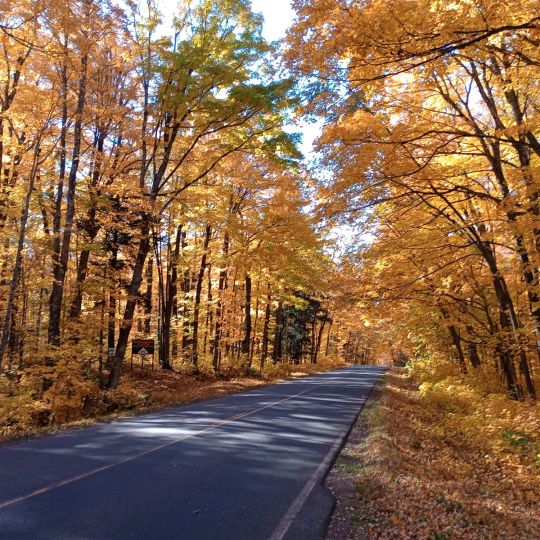







October road trips are pretty unparalleled tbh. Found a Jesus that matches my Mary and even with frame damage it was a magnificent steal. Had some shit weather towards the end but it was a much needed get-the-fuck-outta-Dodge.
Working on pics and cooking. Chicken stock, air fryer wing rub experiments, arrabiata for weekend, choco/pb no bake cookies, sumac rice, tzatziki, toum, hummus and all the mf fresh herbs & veg money can buy. Watermelon radishes never been bought(en) so fast. ydek
Gone exactly long enough to feel snuggled by jake brakes and the nonsensical chattering from random packs of wild Jennifers. It won't last but I'll enjoy it til I can't. Missed you fuckers. 308's main though! Thunderstorm rolling in at night with Halloween around the corner? I'll have it, thanks.

Time for a few beers and something scary. Maybe some hits. S'mores w/ a torch. (ok, dabs)
9 notes
·
View notes
Text
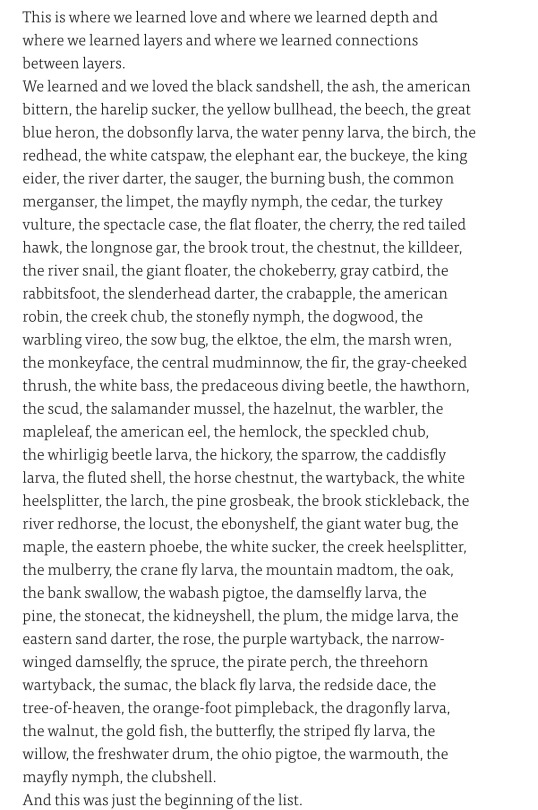

This is where we learned love and where we learned depth and where we learned layers and where we learned connections between layers. We learned and we loved the black sandshell, the ash, the american bittern, the harelip sucker, the yellow bullhead, the beech, the great blue heron, the dobsonfly larva, the water penny larva, the birch, the redhead, the white catspaw, the elephant ear, the buckeye, the king eider, the river darter, the sauger, the burning bush, the common merganser, the limpet, the mayfly nymph, the cedar, the turkey vulture, the spectacle case, the flat floater, the cherry, the red tailed hawk, the longnose gar, the brook trout, the chestnut, the killdeer, the river snail, the giant floater, the chokeberry, gray catbird, the rabbitsfoot, the slenderhead darter, the crabapple, the american robin, the creek chub, the stonefly nymph, the dogwood, the warbling vireo, the sow bug, the elktoe, the elm, the marsh wren, the monkeyface, the central mudminnow, the fir, the gray-cheeked thrush, the white bass, the predaceous diving beetle, the hawthorn, the scud, the salamander mussel, the hazelnut, the warbler, the mapleleaf, the american eel, the hemlock, the speckled chub, the whirligig beetle larva, the hickory, the sparrow, the caddisfly larva, the fluted shell, the horse chestnut, the wartyback, the white heelsplitter, the larch, the pine grosbeak, the brook stickleback, the river redhorse, the locust, the ebonyshelf, the giant water bug, the maple, the eastern phoebe, the white sucker, the creek heelsplitter, the mulberry, the crane fly larva, the mountain madtom, the oak, the bank swallow, the wabash pigtoe, the damselfly larva, the pine, the stonecat, the kidneyshell, the plum, the midge larva, the eastern sand darter, the rose, the purple wartyback, the narrow-winged damselfly, the spruce, the pirate perch, the threehorn wartyback, the sumac, the black fly larva, the redside dace, the tree-of-heaven, the orange-foot pimpleback, the dragonfly larva, the walnut, the gold fish, the butterfly, the striped fly larva, the willow, the freshwater drum, the ohio pigtoe, the warmouth, the mayfly nymph, the clubshell. And this was just the beginning of the list. Our hearts took on many things. Our hearts took on new shapes, new shapes every day as we went to the stream every day. Our hearts took on the shape of well-defined riffles and pools, clean substrates, woody debris, meandering channels, floodplains, and mature streamside forests. Our hearts took on the shape of the stream and became riffled and calmed and muddy and clean and flooded and shrunken dry. Our hearts took on the shape of whirligigs swirling across the water. We shaped our hearts into the sycamore trees along the side of the stream and we let into our hearts the long pendulous polygamous racemes of its small green flowers, the first-formed male flowers with no pistil and then the later arriving hairy ovary with its two curved stigmas. We let ourselves love the one day of the adult life of the mayfly as it warms, mates in flight, and dies all without eating. And we shaped our hearts into the water willow and into the eggs spawned in the water willow. Our hearts took on the brilliant blues, reds, and oranges of breeding male rainbow darter and our hearts swam to the female rainbow darter and we poked her side with our snout as she buried herself under the gravel and we laid upon her as she vibrated. We let leaves and algae into our hearts and then we let the mollusks and the insects and we let the midge larvae into our heart and then the stonefly nymph and then a minnow came into our heart and with it a bass and then we let the blue heron fly in, the raccoon amble by, the snapping turtle and the watersnake also. We immersed ourselves in the shallow stream. We lied down on the rocks on our narrow pillow stone and let the water pass over us and our heart was bathed in glochida and other things that attach to the flesh. And as we did this we sang.
—Juliana Spahr, from “Gentle Now, Don’t Add to Heartache” (x)
2 notes
·
View notes
Text
Beautiful Winged Sumac is Currently in Full Bloom
Beautiful Winged Sumac is Currently in Full Bloom shows readers one of Florida’s earliest fall wildflowers. It explains a bit about their blooming cycle and how attractive they are to pollinators.
Star of Sumac On my last trip out to Gothe State Forest the winged sumac (Rhus copallinum) was blooming everywhere. It’s one of our earliest fall wildflowers and is very impressive when in full bloom. Each plant has multiple stalks and each stalk has hundreds of small yellow and red flowers and light green buds in clusters. The flowers are very short lived, but all of the buds don’t open at…

View On WordPress
#beautiful wildflowers#colorful wildflowers#dwarf sumac#fall wildflowers#flameleaf sumac#Florida sumac#Florida wildflowers#photography#shining sumac#sumac#sumac flowers#sumac photographs#wildflower photographs#wildflower photography#wildflowers#Winged sumac#winged sumac flowers#yellow and red wildflowers
0 notes
Text
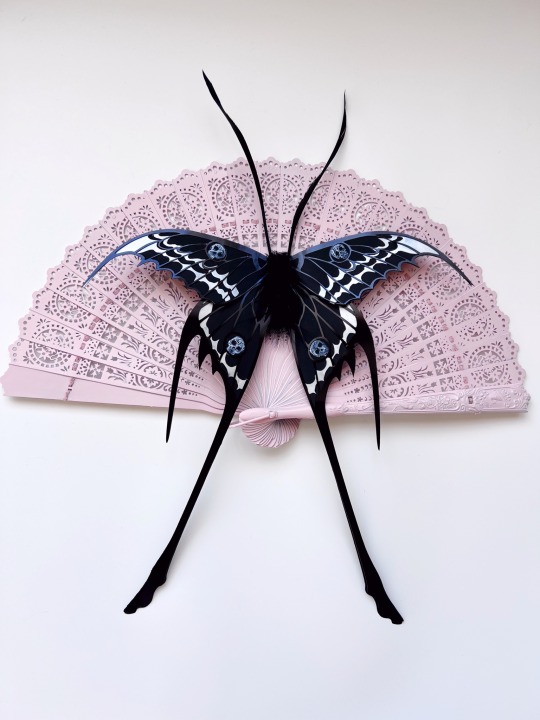
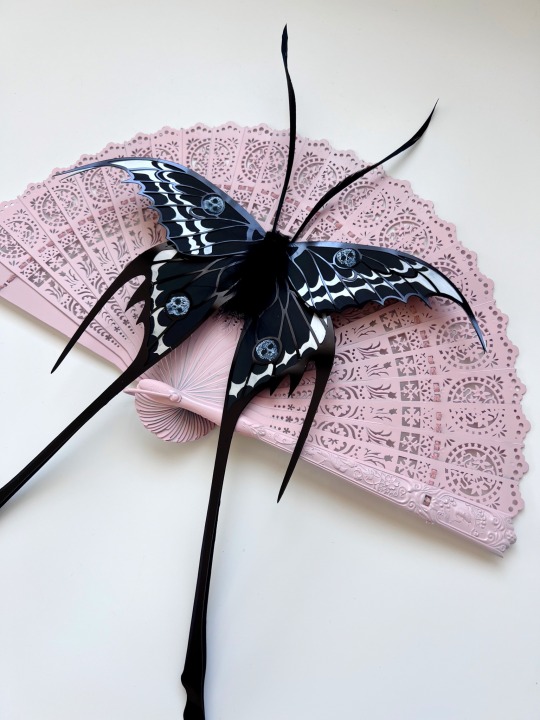
Black Viscount Moth - usually called the bat moth, scientific name Gothica morsus cranii
Indigenous to the Americas, the Black Viscount is found in mid-growth wooded areas, primarily feeding on nectar and sumac. They are very large - they can get up to fifteen inches in length. Despite the similarities in wing shape, they are not closely related to Luna moths.
They do not share the fame and sinister reputation of Deathshead hawk moths, being far less widely known outside entomology circles - which is unfortunate for humans, as bat moths are far more deadly. Deathsheads are quite gentle and are only legendary harbingers of doom because of their markings and squeaks. Unlike most other moth species, bat moths can be aggressive if threatened and cause severe reactions in humans. Just brief contact with the tails can cause dizziness and disorientation, and contact with the full wings can often result in nausea and vomiting. Adult moths do not have mouths - they have instead proboscises, used to suck liquid from plants or other sources. The bat moth proboscis is unique - it is rigid and doubles as a defence mechanism. A threatened bat moth can puncture skin with its “fang”, resulting in coma or even death.
They “hibernate” in the winter, and have a lifespan of up to five years. If you see one on a walk, be sure to admire it from afar.
29 notes
·
View notes
Text
And rooting itself in final place as number ten of the 🐉Wings of Fire aus names lists are...
The 🌲LeafWings🍂!
The X-Men Members:
• Charles Xavier/Professor Xavier: Xanthium
• Ororo Munroe/Storm: Oleander
• Logan Howlett/Wolverine: Walnut
• Scott Summers/Cyclops: Sumac
• Jean Grey/Marvel Girl/Phoenix: Juniper
• Hank McCoy/Beast: Hawthorn
• Anne-Marie/Rogue: Mahogany
• Remy LeBeau/Gambit: Redwood
• Kitty Pryde/Shadowcat: Pecan
• Kurt Wagner/Nightcrawler: Nightshade
• Jubilation Lee/Jubilee: Lily
• Evan Daniels/Spyke: Spruce
• Bobby Drake/Iceman: Mandrake
• Piotr Rasputin/Colossus: Columbine
• Illyana Rasputin/Magik: Iris
• Rahne Sinclair/Wolfsbane: Wolfsbane
• Samuel "Sam" Guthrie/Cannonball: Calla
• Roberto da Costa/Sunspot: Sundew
• Danielle "Dani" Moonstar/Mirage: Mistletoe
• Laura Kinney/Wolverine 2.0: Laurel
•Tabitha "Tabby" Smith/Boom-Boom: Tansy
The Brotherhood:
• Erik Lehnsherr/Magnus/Magneto: Magnolia
• Raven Darkholme/Mystique: Holly
• Victor Creed/Sabretooth: Cedar
• Pietro Maximoff/Quicksilver: Poplar
• Wanda Maximoff/Scarlet Witch: Willow
• Mortymer Tonybee/Todd Tolansky/Toad: Sycamore
• Fred "Freddy" Dukes/Blob: Bloodroot
• Lance Alvers/Avalanche: Larkspur
• St. John Allerdyce/Pyro: Pine
(I believe this has grown its' way to the end... but we have one more bud to bloom before this is over, and it is the...)
• Reader/Bby: Ginkgo, Oak, Banyan, Maple, Beech, Palm, Elm, Chestnut, Birch, Hickory, Eucalyptus, Yew, Fir, Ivy, Sumac, Snakeroot, Hellebore, Foxglove, Crocus, Saffron, Poinsettia, Snowdrop, Hyacinth, Azalea...
#honeycomb thoughts#platonic yandere marvel#yandere platonic marvel#platonic yandere marvel x reader#platonic yandere xmen#yandere x-men#platonic yandere#platonic yandere x reader#🐉Wings of Fire AU#��LeafWing🍂 AU
20 notes
·
View notes
Text
Next on the menu 🍽️ is a steaming pot of fresh winged sumac (Rhus copallinum) leaves. I’m using these for the tannin content to prep cotton fabric. Even though I only used a 1:5 leaf:cotton, it turned out a beautiful lemon yellow color.




3 notes
·
View notes
Text
—for Elizabeth Bishop
Tuwee, calls a bird near the house, Tuwee, cries another, downhill in the woods. No wind, early September, beeches and pines,
Sumac aflame, tuwee, tuwee, a question and a faint But definite response, tuwee, tuwee, as if engaged In a conversation expected to continue all afternoon,
Where is?—I’m here?—an upward inflection in Query and in response, a genetic libretto rehearsed Tens of thousands of years beginning to leave its indelible trace,
Clawprint of language, ritual, dense winged seed, Or as someone were slowly buttoning a shirt. I am happy to lie in the grass and listen, as if at the dawn of reason,
To the clear communal command That is flinging creaturely will into existence, Designing itself to desire survival,
Liberty, companionship, Then the bird near me, my bird, stops inquiring, while the other Off in the woods continues calling faintly, but with that upward
Inflection, I’m here, I’m here, I’m here, here, the call opens a path through boughs still clothed By foliage, until it sounds like entreaty, like anxiety, like life
Imitating the pivotal move of Whitman’s "Out of the Cradle," Where the lovebird’s futile song to its absent mate teaches the child Death—which the ocean also whispers—
Death, death, death it softly whispers, Like an old crone bending aside over a cradle, Whitman says, Or the like the teapot in Elizabeth Bishop’s grandmother’s kitchen,
Here at one end of the chain of being, That whistles a song of presence and departure, Creating comfort but also calling for tears.
Birdcall by Alicia Ostriker
2 notes
·
View notes
Text
Magical Oil Recipes - Buffs and Blessings Edition

For anyone looking to brew up a potion for the purposes of augmentation or blessing, here are some recipes I’ve created that you might find useful.
To prepare them, blend the ingredients in such proportions as feels correct for your purposes (or as supplies allow). Use dried material except where indicated. Place a few spoonfuls in a mason jar with a screwtop lid and fill the jar with a bland oil of your choice. (Vegetable oil of the sort you would buy for cooking works fine.) Screw the lid on tightly and shake well to combine, then leave the jar in a dark dry place for 2-4 weeks to steep.
Once steeped, prepare a clean storage bottle (also with a secure lid) and label with the type of oil and the bottling date. Strain the oil through paper towels or cheesecloth to remove the plant material, then bottle immediately. Store away from sunlight and heat for up to one year. Use for spellwork as you see fit.
(Please note that NONE of these potions are meant to be taken internally by any means. Observe all proper safety measures related to glass, fire, and potentially harmful plants as necessary during preparation.)
*- Ingredient is potentially harmful if inhaled or ingested. **- Ingredient should not be used or handled if you are pregnant or nursing.
All-Purpose Blessing Oil For blessing, purification, and consecration.
Lavender
Sweet Basil
Bay Leaf
Patchouli Note: Use Olive Oil for the base.
Brim With Vim Vitality Oil To restore flagging magical energy and clear post-spell haze.
Tangerine (Satsuma) Peel
Cinnamon Stick
Ginger Root
Vervain
Cauldronkeeper Wisdom Oil To enhance intuition and wisdom.
Hazel (leaves or bark)
Elder (berries or bark)
Sage (any color)
Peach Pit (in master bottle) Note: Peach pits contain a small amount of cyanide, which may be released if the pit is broken down. Exercise caution with the finished oil.
Clear the Way Obstacle Remover Oil For overcoming difficulty and attracting new opportunities.
Dried Sumac Berries
Ginger Root
Sweet Basil
Full Moon Lunar Affinity Oil For augmentation of spells attuned to the lunar cycle.
Willow Bark
Jasmine Flowers
Fennel
Mugwort** Note: Use With Caution.
High Noon Solar Affinity Oil For augmentation of spells attuned to the solar cycle.
Calendula Petals
Chamomile
Bay Leaf
Eyebright Note: Use With Caution.
Golden Fields Prosperity Oil For abundance, good fortune, and general well-being.
Sesame or Pumpkin Seeds
Wheat or Barley Kernels
Orange Peel
Honeysuckle
Get Me Through the Day Endurance Oil For a tiny extra boost on those low-energy days.
Lemon Verbena
White Oak Bark
Rosemary
Echinacea**
Hearthside Home Blessing Oil For a comfortable and harmonious home.
Sweet Basil
Vervain
Pine Needles
Willow Bark
Jack-of-all-Trades Work Enhancement Oil For augmentation of workplace abilities.
Sweet Basil
Meadowsweet**
Borage Flowers
Vanilla Bean
Magical Me Power Boost Oil For augmentation of spellcasting.
Ginger Root
Rosemary
Bergamot
Cedar Tips
Steel Backbone Fortitude Oil For bravery and endurance.
Blue Vervain
Pine Needles
Cedar Tips
Yarrow**
Truthteller Divination Oil For augmentation of divinatory practices.
Evening Primrose**
Hibiscus Flowers
Celery Seeds
Tea Leaves
Watchful Eye Viewing Oil To enhance powers of observation.
Grape Leaf
Lemon Balm
Rosemary
Celery Seed (or dried leaf from stalks) Note: Do not apply to skin around eyes. Do not apply directly to eyeballs either.
Should the reader require supplies, I recommend the following:
Penn Herb Company
Starwest Botanicals
Bulk Apothecary
Mountain Rose Herbs
Specialty Bottle
Image Credit - VeraPetruk
All recipes are © 2017 Bree NicGarran, published in Pestlework: A Book of Magical Powders & Oils. Please check out the book if you would like more recipes.
If you’re enjoying my content, please feel free to drop a little something in the tip jar, tune in to my podcast Hex Positive, or check out my published works on Amazon or in the Willow Wings Witch Shop.
390 notes
·
View notes
Text
Local Spotlight: Amy's Wildlife Watch, by Del Blaushild
Winter is upon us, and for a lot of us that means spending all our time inside. But if you're looking for some outdoor fun instead, today's spotlight is for you! I discovered Amy Olson's wildlife club by a happy accident while researching a reader suggestion. SOME of you have manners and chose to use my blog instead of carving up the local rodent life, and for that I thank you. This request was about Sumac's cute, lively, and chillingly intelligent black squirrels!
Black squirrels are a melanistic subgroup of eastern gray squirrels, thought to develop in cold climates to retain heat and blend into dimly-lit environments. Since the melanistic gene is recessive they're hit hard by hunting and deforestation, but they're observed to be more tolerant of humans than the dominant variant. Sumac's black squirrels definitely fit this description, bravely leaping across our porches and squeezing under our garden fences. No covered vegetable or well-tarped secret is safe from our fuzzy little neighbors. They tend to avoid the lake, sticking to wooded areas or places where they can steal a bite of some human treat. One particular part of the woods seems to be their favorite- the area bordering Amy Olson's home.
Many of you remember Amy from her time chairing the Outdoor Recreation Committee several years ago when she was married to Mayor Richardson. But when I ran into her in the woods this weekend, failing to get a clear shot of a one-eyed squirrel demolishing a Buffalo wing, she was a totally new woman. Amy now leads the town's most popular wildlife-spotting club with grace, wit, and plenty of patience for inept city-dwellers like me. She encourages an environment of kindness and curiosity that makes every member of her club feel welcome. She credits her success to the healing power of nature. "I was going through a really tough time around my divorce," she says, "and I spent a lot of time alone in the woods. It brought me so much peace, and that's when I decided to start the club. It's really helped me reconnect with myself. We're all amateurs here, so we do our best and share whatever knowledge we have. I hope everyone in this town can discover that peace someday."
I think that says it all. If you're curious about nature and want to get started with a friendly community, this is the place. And however your first spotting session goes, just know your pictures can't be any worse than mine.

5 notes
·
View notes
